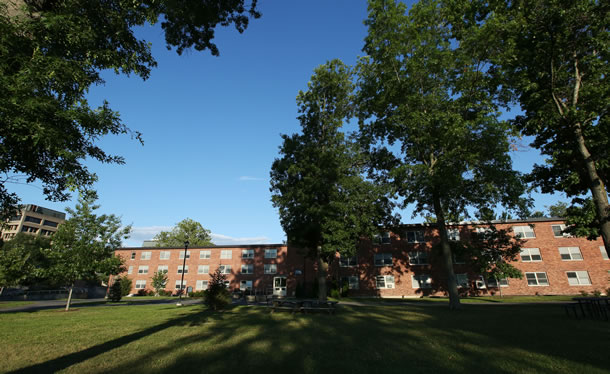
In 1991, an electrical incident contaminated campus buildings at a state college in New Paltz. In this article, we look back at the original incident, and what has changed in the world since then.
By Eric Francis Coppolino
Twenty-five years is a long time in the life of a college campus.
Presidents, not just student government presidents, come and go. New campuses of the same school are built, and others are closed down. Departments and vast domains inside of institutions are reshaped and reformed. If you come back to your old school after that long, you might not recognize the place.

Staff turnover is nearly total after that length of time, so there is little in the way of institutional memory except folklore and what’s kept in the minds of a few old-timers — and the college’s official archives, which lay silent until someone opens that door looking for something.
In terms of the institutional memory of students, it’s rare for that to last for more than a few years. Students arrive and deal with what is happening now, with little connection to the past. Very few student leaders have any idea what was happening on a campus three years earlier, much less a quarter of a century ago.
Twenty-five years ago George H.W. Bush was president; Al Gore hadn’t even come along to tell us about global warming. Those were still the days of the ozone hole.
The Secret Life of Toxins
In the life of persistent toxins, though, 25 years is no time at all. Unlike medicine and food, toxins have no expiry date. The most serious problem with these poisons in the environment is that they last so long, and they move up through the food chain in the direction of humans and other predators. The most serious issue is that each dose adds to what is already in the body, and it stays there (this is called bioaccumulation).
Once deposited into the environment, these same chemicals — many of them made from chlorine — will exist perpetually until removed and dealt with properly. That, sadly, is expensive, difficult and therefore not often on anyone’s agenda. PCBs are not acute toxins; instead they have subtle effects, like rewriting the body’s hormone messages, blocking repair of the genetic code and, of course, the fact of being carcinogens. This leads to a broad spectrum of diseases.
The intersection of toxins and a college campus comes in the form of SUNY New Paltz. I mention 25 years because it was about that long ago when, early one morning, a car crashed into a utility pole, which damaged power cables and led to a rather large chemical and electrical disaster on the New Paltz campus.
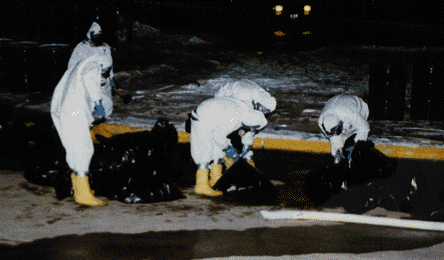
Even though that happened during the first Bush administration and right after the first Iraq War, it’s still relevant today — for many more reasons than it was when it originally happened.
There’s a chemical that has impacted SUNY New Paltz that you may have heard of, called PCBs (properly, polychlorinated biphenyls).
They’re a group of (usually) liquid plastic compounds saturated with so much chlorine that a gallon weighs about 11 pounds (compared to a gallon of oil weighing under eight pounds). During the 20th century they were widely used in electrical equipment, paints, inks, window caulking and even surgical implants. PCBs were so useful to industry that they were put into just about everything at least once. Mostly, though, they were used to fill up electrical equipment such as transformers and capacitors.
The manufacturers — mainly GE, Westinghouse and Monsanto — knew that there were serious defects in their equipment soon after PCBs were first used. They discovered defects in their equipment that were not revealed to end-users.
Though the manufacture of new PCBs and PCB-based equipment was banned by Congress in the late 1970s as an imminent threat to human health and the environment, untold thousands of transformers containing PCBs were left in place, many of them in sad condition.
College Campus Becomes Disaster Area
On that day in 1991, six of the PCB transformers installed in SUNY New Paltz buildings exploded, burned or otherwise released their contents into living areas and classrooms. There was a cleanup, estimated to have cost $50 million, though it was controversial. Key areas were not tested, such as the air vents and radiators in the dorms. Back in the day, these were huge issues, with a constant presence in the news, and the sight of moonsuit-clad cleanup workers was commonplace.
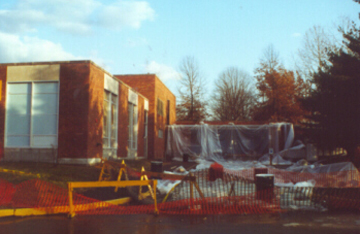
State officials have insisted over the years that the cleanup was impeccable and that there is no danger to students. However, the state’s cleanup guidelines allowed residue of contamination to be left in the buildings.
Many areas were neither tested nor cleaned. And while the state’s testing usually comes back ‘non-detected’, all the times I’ve gone in and personally taken samples I’ve found PCB contamination everywhere I’ve looked: in a wallpaper sample, in topsoil and, most troubling, in samples of dust from the vents and the heaters.
Where there are PCBs there are other chemicals called dioxins and furans. There have been no tests for these compounds taken on campus since early 1992.
The state’s own cleanup guidelines (also called the re-entry guidelines) factored for residual contamination, and allow the campus to kill one student in a million from exposure. That is the standard risk assessment figure: one in a million.
Over the years, I’ve had calls from former residents of the toxic dorms with brain cancer, breast cancer, multiple sclerosis, diabetes and alopecia. They want to know: did I get sick from living in those dorms or on the campus? I say that it’s impossible to tell, but that the exposure they got at New Paltz, even if small, didn’t make them any healthier. Because PCBs and dioxins affect the immune system and the endocrine system first, that can (and often does) facilitate many other problems.
There is No Medical Monitoring
In order to have a real indication of what the toxins in the buildings are doing to the students who live there, it’s necessary to have medical monitoring. That, however, can only be ordered by a court, as part of a lawsuit; the state is not going to do that voluntarily and is under no legal obligation to do so. If we had surveys from every class of students over these 25 years, we would have a much better indication of the issues. And there’s a reason that we would want this.
The most troubling fact about the New Paltz incident is that the risk assessment used to fix the buildings was done in the 1980s, before the incident even happened. It was a standard protocol, but from another era. By the early 1990s, the federal government and industry were well aware of how much less exposure to PCBs and dioxins it took to make someone sick, and using cleanup standards from a prior era did not jive with that.

So while new science was coming in saying that less exposure did more damage, the State of New York’s reentry guidelines were 10 years out of date. But this is not the kind of thing you can explain to anyone easily. It doesn’t make exciting news content. There are no flashing red lights to put on television. The fear factor is subtle — and I cannot count how many times I’ve heard some student tell me the equivalent of “something’s gonna kill you eventually.” That’s true — but you still look when you cross the street.
Then there’s the response: “If this were really a problem, then surely someone would do something about it.”
The bottom line of SUNY New Paltz is that nobody knows how toxic it is, what the real levels are, or how much contamination actually will hurt a student. The toxins are not distributed evenly; weird things happened in some buildings, like the third floor getting higher readings than the first floor, even thought the transformers were in the basements.
A student’s previous exposures to chemicals or to drugs suddenly come into play if they move into one of the toxic dorms. How strong your immune system is suddenly matters, and normal student recreational activities like smoking cigarettes and drinking alcohol can have an impact.
Now, how concerned should a student or parent be? That’s pretty personal, and it would be a choice rooted in your values. There are many environmental concerns in the world right now, and I would say that as a rule, the less exposure to any chemical, the better.
Twenty-Five Years in the Life of the World
Twenty-five years is a long time for a campus, though in environmental history, it’s a long time in the world as well. Back in December 1991, when the PCB incident happened at New Paltz, George H.W. Bush was president.
I know we all long for those simpler times, when there were no more serious environmental issues. Most people had not heard of Al Gore. The term ‘global warming’ was still so new most people hadn’t heard of it. Those were days of the ozone hole.
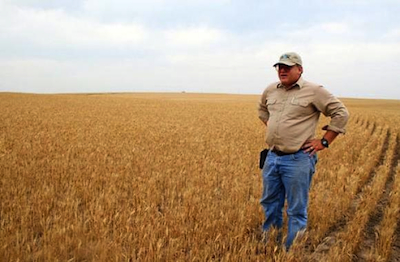
It was still three years before Monsanto began production of bovine somatotropin (BSP), a genetically engineered supplement that forces dairy cows to increase milk production. That came out in 1994.
It would be five years until Monsanto released the first ‘Roundup-ready’ seed; that is, seed that is genetically engineered to withstand application of the herbicide glyphosate, which is listed as a probable carcinogen. (It’s basically the new PCBs, which were made by Monsanto). Since then many, many other genetically engineered crops have been introduced.
According to Environmental Sciences Europe, “Globally, glyphosate use has risen almost 15-fold since so-called ‘Roundup-ready’, genetically engineered glyphosate-tolerant crops were introduced in 1996. Two-thirds of the total volume of glyphosate is applied in the U.S.”
The Detox Project recently reported that 93% of urine samples from Americans tested positive for glyphosate. In other words, since the day that New Paltz happened, the world and our bodies have become a Roundup dumpsite, all in the name of GMO foods. The American people tend to power themselves on corn: tortillas, tacos, corn chips, corn syrup in soda and plenty else; nearly all of it is contaminated with glyphosate.
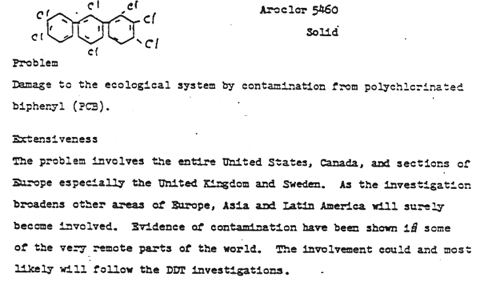
What are called the “synergistic effects” — that is, the compounded effects of adding together multiple toxins — are never studied by science. Safety studies, if they’re done at all, go one chemical at a time.
Doctors and pharmacists are concerned about drug interactions, though chemical and agricultural firms don’t seem to be concerned about the effects of combining their toxic chemicals. Neither do scientists or the EPA look into this much. Since there are tens of thousands of approved chemicals on the market, there would be a lot to investigate if you multiplied them all by one another.
It would be interesting just look at the interactive effects of glyphosate and PCBs — two of Monsanto’s most successful chemicals.
And Then There’s Fukushima
At around the 20th anniversary of New Paltz, the Fukushima incident happened. General Electric — a company widely involved with the PCB problem — designed nuclear reactors that, though totally unsuitable for the purpose, were built in an earthquake and tsunami zone.
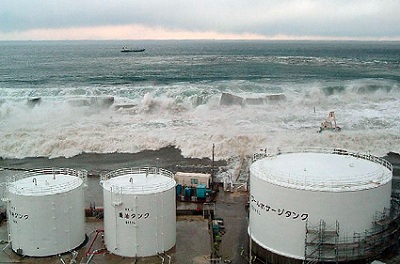
Bad design decisions were made, such as putting the backup generators in the basement, where water could get in and destroy them in an instant.
That didn’t work out well. Now we live with somewhere around 500 to 1,000 tons of nuclear waste burning into the Earth next to the Pacific Ocean, and gradually seeping into the water.
Nobody is really talking about this; it’s a nonissue these days, even though there are many, many potential problems at that disaster scene, as there are with every other nuclear power plant in the world. (Those of us in the Hudson Valley would be wise to devote some attention to the Indian Point nuclear reactor, one of the oldest and most decrepit in the nation.)
We all have to deal with the potential effects of increased radiation, particularly in fish. There is no way to test every single fish for radiation, so some are going to get out and into the food supply. It’s just that Fukushima itself has been swept under the rug, with little resistance from anyone.
And if you can distract people from, or somehow hide away, the dangers of multiple nuclear meltdowns, it’s pretty easy to hide the potential dangers of a PCB accident on a college campus. They have many other things in common, though the most important is this: you can only find out as much as you want to know.
—-
Eric Francis Coppolino is a reporter whose work on environmental toxins and fraud has been published by Sierra Magazine, The Ecologist, The Village Voice, The Woodstock Times, The Las Vegas Sun and other media. A compilation of his work on New Paltz, PCBs and dioxins can be found at the Dioxin Dorms website.



